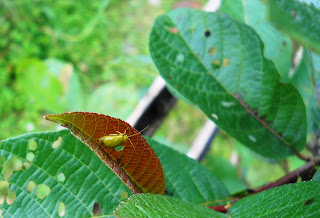This blog may help people explore some of the 'hidden' issues involved in certain media treatments of environmental and scientific issues. Using personal digital images, it's also intended to emphasise seasonal (and other) changes in natural history of the Swansea (South Wales) area. The material should help participants in field-based modules and people generally interested in the natural world. The views are wholly those of the author.
Sunday, 30 October 2011
Thursday, 27 October 2011
'Frozen Planet' Fundamentals
In one sense it is gratifying (and important) that the first programme in the 85-year old David Attenborough's 'Frozen Planet' series attracted 6.8 million viewers (http://www.guardian.co.uk/media/2011/oct/27/david-attenborough-frozen-planet?newsfeed=true). This is still considerably less than 'Strictly Come Dancing's' 9.4 million but, hey, the dancing abilities of a group of 'celebrities' is clearly more important than what is happening on a planetary basis! There is no doubt that the photography in 'Frozen Planet' was generally stunning and the animal 'mini-dramas' appeared broadly accurate and compelling (if the outcomes appeared occasionally 'cosmetic') but I found the flicking for examples between the north and south poles somewhat confusing (and this is someone who knows something about the two regions already). Like some others, I am a bit ambivalent about the associated music. I am not certain that Attenborough's claim that we might be seeing some of the animals for the last time is true but it is worth thinking about.
Wednesday, 26 October 2011
Saltatory Sandhoppers!
Caught in torrential rain whilst jogging between Blackpill and West Cross, I noted sandhoppers bouncing across the cycle path from the seaward to the landward side. I can't think of a reason why they would do this unless they all happened to be operating on the seaward side and the path was perceived as getting away from the rainwater.
Cactus Rustling
News that two Germans have been arrested in Mexico with 543 cactus specimens in their suitcases (http://www.guardian.co.uk/world/2011/oct/25/germans-detained-cacti-mexico-airport?INTCMP=SRCH). These included several endangered species. This just goes to confirm my belief that gardeners are a major menace to conservation!
Sunday, 23 October 2011
Contrary Effects of a Malaria Vaccine?
It would be a churlish, callous individual who did not applaud the technical breakthrough of scientists developing a vaccine for malaria capable of halving death and morbidity in African children (http://www.bmj.com/content/343/bmj.d6832.extract). This is the first time that a vaccine has been developed to a protozoan parasite and this, along with the distribution of bed nets and effective mosquito control, could transform human population dynamics in the sub-Saharan region, especially if vaccine use is encouraged by the Bill and Melinda Gates Foundation. This 'technofix' will not, however, come without some associated problems. The malarial agent is very variable and it might well prove difficult for vaccine development to stay 'ahead of the game'. A second problem is that, without a rapid change in reproductive behaviour, the increased survival might well lead to later economic development problems in the region. Finally, there has been some recent predictions that the world population for humans will reach around 10 billion by 2050 (http://www.worldwatch.org/node/6038). If this occurs, it might well prove to be catastrophic for the planet and its inhabitants. Child death and morbidity is not a good way to curtail population increases (by no means limited to Africa) but I would argue that vaccine application should be accompanied by dissemination of contraceptive advice and technology.
Thursday, 20 October 2011
Dangerous for Who?
Somewhat disturbing news from Zanesville, Ohio USA where a Farm owner apparently released 'his' collection of around 48 'dangerous' animals shortly before shooting himself(http://www.guardian.co.uk/world/2011/oct/19/ohio-dangerous-animals-breakout?INTCMP=SRCH). Rather predictably, the lions, tigers, bears, wolves etc also ended up being shot by the local police force (last I heard was that one 'monkey' was still 'on the run') who took the view that doing any less was imperilling the public. It is difficult to guess at the motivation of the Farm owner but it is rather sad that many endangered animals ended up being slaughtered for no good reason. Perhaps the Ohio laws on keeping exotic species need strengthening?
Saturday, 15 October 2011
Monday, 3 October 2011
Seeing the Changes 428
After record hot weather at the end of September, it became markedly cooler yesterday. The fungus Boletus badius was evident in Bynea along with some Gower ponies who appeared to have crossed the river. Lots of lepidopteran larvae were evident on the cycle path and a strange thrush-sized bird with a white rump operated on the strand line (some kind of plover?).
Himalayan Highlights 6. Beetles
There were masses of beetles ranging from a large, long-horn beetle, a weevil and a cockchafer at the Hidden Forest Retreat to various stag beetles attracted to the lights of the Guru Padmasambhava statue (some alive but most dead). A tiny cockchafer was caught in a web near the Temi Tea Plantation. A range of beetles were also spotted on plants throughout the area.
Himalayan Highlights 4. Spiders
There were lots of interesting spiders. The Golden orb web spider (Nephila clavata) was found virtually everywhere. There were impressive Argiope spiders at some of the shrines and a very odd beast with a 'target' web near the government buildings in Gangtok. One can add to this an array of wolf and other arachnids.
Himalayan Highlights 3. Mammals
Spotted my first Orange-bellied Himalayan squirrel (Dremomys lokriah) at the Hidden Forest Retreat. There were lots of Hanuman langurs (Semnopithecus entellus) on the road from West Bengal. Dogs (Canis familiaris) abound even on the main street (MG Marg) but only operate at night (they don't have any sweat glands). At the Himalayan Zoological Park, recorded the State Mammal- the Red panda or 'shining cat' (Ailurus fulgens) and the Himalayan black bear (Selenarctos thibetanus laniger).
Subscribe to:
Comments (Atom)
-
I n the UK and US, a pparently popular and successful vegan/vegetarian restaurants are reportedly closing or adding meat to their menus ( ...
-
Early ripening fruit may seem convenient but some folk think it confirms environmental stress. There's also a possibility th...






















































%20mating%20NWCW.jpg)

